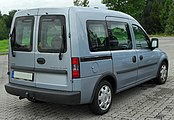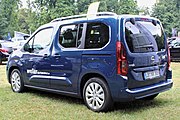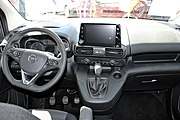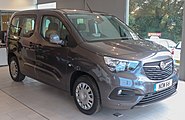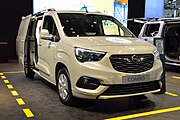Opel Combo
| Opel Combo | |
|---|---|
| Production period: | since 1986 |
| Class : | Utilities |
| Body versions : | High roof station wagon , panel van |
The Opel Combo is the name of various generations of commercial vehicles from the Opel brand .
The first two generations were panel van variants from the Kadett E or Corsa B . The third generation is a leisure activity vehicle based on the Opel Corsa C . From autumn 2011 to spring 2018, the fourth generation was offered, which was based on the Gamma platform "SCCS" jointly developed by GM (Opel) and Fiat . Together with the sister model Fiat Doblò II , the combo was built by the contract manufacturer Tofaş .
The fifth generation of the combo was developed together with PSA and has been available since summer 2018. The base is also used by the sister models Peugeot Rifter , Citroën Berlingo and Toyota ProAce City , which are all almost identical.
In Australia and New Zealand the Opel Combo is sold as the Holden Combo , in the UK as the Vauxhall Combo , in Chile as the Chevrolet Combo .
Cadet Combo (Combo A; 1986-1993)
| 1st generation | |
|---|---|
|
Opel Combo (1989-1993) |
|
| Production period: | 1986-1993 |
| Body versions : | High roof station wagon , panel van |
| Engines: |
Gasoline engines : 1.3 to 1.6 liters (44 to 66 kW) diesel engines : 1.6 to 1.7 liters (40 to 44 kW) |
| Length: | 4221 mm |
| Width: | 1674 mm |
| Height: | 1670 mm |
| Wheelbase : | 1530 mm |
| Empty weight : | 1005 kg |
For the first time the model name Opel Combo was introduced in a van, which on the Opel Kadett E based. It was built from January 1986 to August 1993 and thus exceeded the construction time of its platform encoder.
Instead of the twist beam axle of the Kadett, a rigid axle on leaf springs was installed at the rear , which enabled a higher payload.
Combo B (1993-2001)
| 2nd generation | |
|---|---|
|
Opel Combo (1993-2001) |
|
| Production period: | 1993-2001 |
| Body versions : | High roof station wagon , panel van |
| Engines: |
Otto engines : 1.2–1.4 liters (33–60 kW) Diesel engines : 1.7 liters (44 kW) |
| Length: | 4230 mm |
| Width: | 1686 mm |
| Height: | 1853 mm |
| Wheelbase : | 1380 mm |
| Empty weight : | 1130 kg |
In October 1993, Opel presented the Combo B, which is based on the Corsa B introduced at the beginning of the same year . Like the previous model, it only has two seats in the driver's cab that is open to the rear. In addition, it has a closed box structure with two wing doors in the rear that can be opened to almost the full width and height of the cargo space.
In the summer of 1995, the Combo Tour was also introduced with a second bench seat and windows in the rear of the vehicle.
The combo was available with a gasoline engine and a diesel engine . The Otto engine had a displacement of 1389 cm³ and developed 44 kW. Its gross vehicle weight was 1620 kg, while its curb weight was 1130 kg.
Production was stopped in August 2001.
Combo C (2001-2011)
| 3rd generation | |
|---|---|
|
Opel Combo panel van (2001-2003) |
|
| Production period: | 2001-2011 |
| Body versions : | High roof station wagon , panel van |
| Engines: |
Petrol engines : 1.4–1.6 liters (64–66 kW) 1.6 liters CNG (69 kW) Diesel engines : 1.3–1.7 liters (48–74 kW) |
| Length: | 4332 mm |
| Width: | 1684 mm |
| Height: | 1801 mm |
| Wheelbase : | 2716 mm |
| Empty weight : | 1235 kg |
In October 2001 the Combo C based on the Corsa C came onto the market. The sliding side doors arranged on both sides were new in this generation . As a fully glazed van for the private market, which could be recognized by the chrome strut on the grill, it was called Combo Combi or Combo Tour .
The high-roof combination with partial glazing intended for commercial use was only sold under the name Combo and the panel van under the name Combo panel van . Due to the width of the loading area between the wheel arches of 1107 mm, the Combo C could only transport one Euro pallet.
The front structure, including the front axle construction, was taken over from the Corsa C, the torsion beam axle installed at the rear is similar to the version known from Meriva A and Astra G.
Together with the Corsa C, the non-commercial version of the Combo received a slight facelift in the summer of 2003, including widening the chrome strut in the radiator grille, which is typical of Opel, and redesigning the front bumper. The new infotainment generation was also used with the facelift.
From 2005 the special model Tramp was available, which was available from 2007 under the name Arizona. An underride guard and a lift by 20 mm were installed as standard.
The combo was built in the Figueruelas plant from the beginning of 2007 , where production was relocated after the production in Azambuja (Portugal) was closed.
In October 2010, the production of the Combo Tour was discontinued because the model could not meet the Euro 5 emission standard for cars that was required from the beginning of 2011 . Production of the Combo C panel van continued until January 2011.
Technical specifications
| Opel Combo | 1.4 TWINPORT ecoFLEX |
1.6 | 1.6 CNG ecoFLEX |
1.3 CDTI | 1.3 CDTI ecoFLEX |
1.7 TUE | 1.7 DTI | 1.7 CDTI |
|---|---|---|---|---|---|---|---|---|
| Construction period | 07/2004 - 09/2010 | 03/2002 - 06/2004 | 04/2005 - 09/2010 | 07/2004 - 09/2006 | 11/2005 - 09/2010 | 03/2002 - 06/2004 | 03/2002 - 06/2004 | 07/2004 - 09/2010 |
| Engine designation | Z14XEP | Z16SE | Z16YNG | Z13DT | Z13DTJ | Y17DTL | Y17DT | Z17DTH |
| Engine type | R4 petrol engine | R4 diesel engine | ||||||
| Mixture preparation | Multi-point injection | Common rail injection | Direct injection | Common rail injection | ||||
| Engine charging | - | Turbocharger, intercooler | turbocharger | Turbocharger, intercooler | ||||
| Displacement | 1364 cc | 1598 cc | 1248 cc | 1686 cc | ||||
| Number of valves per cylinder | 4th | 2 | 4th | |||||
| Valve control | DOHC, chain | OHC, timing belt | DOHC, timing belt | DOHC, chain | DOHC, timing belt | |||
| Max. Power at 1 / min |
66 kW (90 PS) / 5600 |
64 kW (87 PS) / 5400 |
69 kW (94 PS) / 6200 |
51 kW (70 PS) / 4000 |
55 kW (75 PS) / 4000 |
48 kW (65 PS) / 4400 |
55 kW (75 PS) / 4400 |
74 kW (100 PS) / 4400 |
| Max. Torque at 1 / min |
125 Nm / 4000 |
138 Nm / 3000 |
133 Nm / 4200 |
170 Nm / 1750-2500 |
170 Nm / 1750-2500 |
130 Nm / 2000-3000 |
165 Nm / 1800-3000 |
240 Nm / 2300 |
| Gearbox, as standard | 5-speed manual transmission | |||||||
| Gearbox, optional | - | 5-speed Easytronic | - | |||||
| Top speed | 164 km / h | 164 km / h | 166 km / h | 150 km / h | 152 km / h 152 km / h (1) |
147 km / h | 155 km / h | 170 km / h |
| Acceleration in s from 0–100 km / h |
14.0 | 14.0 | 14.0 | 17.0 | 17.0 | 18.5 | 15.5 | 12.5 |
| Combined fuel consumption in l / 100 km according to EEC directive 1999/100 EC |
6.3 S. | 7.8 S | 4.9 kg or 7.5 m 3 of H gas |
5.1D | 5.1 D 5.0 D 1 |
5.4 D | 5.4 D | 5.2 D |
| CO 2 emissions, combined | 151 g / km | 188 g / km | 133 g / km | 138 g / km | 134 g / km 135 g / km 1 |
146 g / km | 146 g / km | 140 g / km |
| Emission standard according to EU classification | Euro 4 | Euro 3 | Euro 4 | |||||
Combo D (2011-2018)
| 4th generation | |
|---|---|
|
Opel Combo station wagon (2011-2017) |
|
| Production period: | 2011-2018 |
| Body versions : | High roof station wagon , panel van |
| Engines: |
Otto engines : 1.4 liters (70–88 kW) Diesel engines : 1.3–2.0 liters (66–99 kW) |
| Length: | 4390-4740 mm |
| Width: | 1831 mm |
| Height: | 1845-2115 mm |
| Wheelbase : | 2755-3105 mm |
| Empty weight : | 1240-1540 kg |
Like the Fiat Doblò II presented earlier, the Combo D generation is based on the SCCS platform ( Opel Corsa D and Fiat Punto ). The Combo D was manufactured by Tofaş in Bursa together with the Fiat Doblò .
Like its predecessors, the Combo D was available in two versions: as a car and a delivery van, which was again called the "panel van". Like other vans , the Combo D was available with two wheelbases and two roof heights. The loading volume ranged from 3.8 m³ for cars to 4.6 m³ for vans, a payload of up to one ton and even the short version offered space for two Euro pallets. In the car variant, there was the combo with five or seven seats.
The Combo D went on sale on January 14, 2012. At the market launch, the Combo D was offered with a gasoline engine and four diesel engines with a power range from 66 kW (90 PS) to 99 kW (135 PS). A natural gas variant has also been available since the start of sales. The tank capacity of this model was 22 liters of petrol or 16.15 kg of natural gas.
Technical specifications
| Parameters | 1.4 (1) (2) | 1.4 turbo | 1.4 CNG Turbo ecoFLEX (3) | 1.3 CDTI (1) (2) (4) | 1.6 CDTI (1) | 1.6 CDTI (1) (2) (4) | 2.0 CDTI (1) | |||||
|---|---|---|---|---|---|---|---|---|---|---|---|---|
| Construction period | 02 / 2012-08 / 2017 | 06 / 2014-08 / 2017 | 02 / 2012-08 / 2017 | 02 / 2012–03 / 2016 | 03/2016–08/2017 | 02 / 2012–03 / 2015 | 02 / 2012–03 / 2016 | 04/2015–06/2017 (5) | 09 / 2016-08 / 2017 (6) | 02 / 2012-08 / 2017 | 04/2015 (7) | 02 / 2012–03 / 2016 (8) |
| Engine type | R4 petrol engine | R4 petrol engine , gas | R4 diesel engine | |||||||||
| Mixture preparation | Manifold injection | Common rail injection | ||||||||||
| Engine charging | - | turbocharger | ||||||||||
| Displacement | 1368 cc | 1248 cc | 1598 cc | 1956 cc | ||||||||
| Max. Power at 1 / min |
70 kW (95 PS) / 6000 |
88 kW (120 PS) / 5000 |
66 kW (90 PS) / 4000 |
70 kW (95 PS) / 4000 |
66 kW (90 PS) / 4000 |
70 kW (95 PS) / 4000 |
74 kW (100 PS) / 3650 |
77 kW (105 PS) / 4000 |
88 kW (120 PS) / 3500 |
99 kW (135 PS) / 3500 |
||
| Max. Torque at 1 / min |
127 Nm / 4500 |
206 Nm / 3000 |
206 Nm / 3000 |
200 Nm / 1500 |
290 Nm / 1500 |
200 Nm / 1500 |
300 Nm / 1750 |
290 Nm / 1500 |
320 Nm / 1750 |
320 Nm / 1500 |
||
| drive | Front wheel drive | |||||||||||
| Gearbox, as standard | 5-speed manual transmission | 6-speed manual transmission | 5-speed manual transmission | 6-speed manual transmission | ||||||||
| Gearbox, optional | - | 5-speed Easytronic (9) | - | |||||||||
| Top speed | 161 km / h | 172 km / h | 158 km / h | 159 km / h (161 km / h) |
158 km / h [158 km / h] |
158 km / h | 164 km / h | 160 km / h (164 km / h) |
172 km / h (176 km / h) |
179 km / h | ||
| Acceleration, 0-100 km / h |
15.4 s | 11.0 s | 12.3 s | 17.2 s | k. A. | 14.9 s [14.9 s] |
14.3 s | 13.4 s | k. A. | 13.1 s | 11.3 s | |
| Fuel consumption over 100 km (combined) |
7.4–7.6 l S (7.2–7.4 l S) |
7.2-7.4 s | 7.5 l S 4.9 kg natural gas |
5.1 L D (4.9 L D) |
5.1 L D (4.7 L D) |
5.5-5.9 l D [5.4-5.9 l D] |
(5.2-5.6 L D) ([5.0-5.5 L D]) |
5.2 L D (4.7 L D) |
5.5-5.9 L D (5.2-5.6 L D) |
5.1–6.0 l D (4.5–5.0 l D) |
5.2-5.7 L D (4.6-5.0 L D) |
5.9–6.2 L D (5.7–6.0 L D) |
| Combined CO 2 emissions in g / km |
169-177 (163-171) |
169-179 | 134 | 136 (129) |
136 (123) |
145-156 [141-157] |
(138-148) ([133-147]) |
137 (124) |
145-156 (138-148) |
134-158 (120-133) |
136-149 (124-140) |
156-163 (150-157) |
|
Emission standard according to EU classification |
Euro 5 / Euro 6 (10) | Euro 6 | Euro 5 / Euro 6 10 | 5 euro | Euro 6 | 5 euro | Euro 6 | Euro 5 / Euro 6 (11) | Euro 6 | Euro 6 | 5 euro | |
- Values in [] brackets apply to the Easytronic automated manual transmission .
- Values in () brackets apply to vehicles with the ecoFLEX automatic start-stop system (except 1.4 CNG Turbo ecoFLEX).
Combo E (since 2018)
| 5th generation | |
|---|---|
|
Opel Combo Life (since 2018) |
|
| Production period: | since 2018 |
| Body versions : | Leisure activity vehicle , van , MiniVan |
| Engines: |
Otto engines : 1.2 liters (81–96 kW) Diesel engines : 1.5 liters (56–96 kW) |
| Length: | 4403-4753 mm |
| Width: | 1848 mm |
| Height: | 1841-1880 mm |
| Wheelbase : | 2785-2977 mm |
| Empty weight : | 1410-1615 kg |
| Stars in the Euro NCAP - Crash Test (2018) |
|
The fifth generation of Combo builds on the EMP2 platform of the PSA -Konzerns and is in much of the same design as the third generation of the Citroen Berlingo , the Peugeot Rifter and the Toyota PROACE City . The combo is built in the PSA plants in Vigo (Spain) and Mangualde (Portugal). The vehicles differ in the front section, the design of the cockpit and in equipment variants. The Combo E is again available with two wheelbases - as Life and Life XL . The car version has been on sale since June 2018 at prices starting at 19,995 euros. The first vehicles have been delivered since September 29, 2018. The panel van variants are offered as Combo Cargo (length 4.4 m) and Combo Cargo XL (4.75 m).
safety
In Euro NCAP - Crash test the vehicle in 2018 with four stars out of five was evaluated.
Technical specifications
| Parameters | Combo Life 1.2 | Combo Life 1.5 diesel | ||||||||||||||||||||||||||||||||||||||||||||||||||||||||||||||||
|---|---|---|---|---|---|---|---|---|---|---|---|---|---|---|---|---|---|---|---|---|---|---|---|---|---|---|---|---|---|---|---|---|---|---|---|---|---|---|---|---|---|---|---|---|---|---|---|---|---|---|---|---|---|---|---|---|---|---|---|---|---|---|---|---|---|---|
| Construction period | 09 / 2018-06 / 2019 | since 06/2019 | 09 / 2018-06 / 2019 | since 09/2018 | ||||||||||||||||||||||||||||||||||||||||||||||||||||||||||||||
| Engine type | R3 petrol engine | R4 diesel engine | ||||||||||||||||||||||||||||||||||||||||||||||||||||||||||||||||
| Mixture preparation | Direct injection | Common rail injection | ||||||||||||||||||||||||||||||||||||||||||||||||||||||||||||||||
| Engine charging | turbocharger | |||||||||||||||||||||||||||||||||||||||||||||||||||||||||||||||||
| Displacement | 1199 cc | 1499 cc | ||||||||||||||||||||||||||||||||||||||||||||||||||||||||||||||||
| Max. Power at 1 / min |
81 kW (110 PS) / 5500 |
96 kW (130 PS) / 5500 |
56 kW (76 PS) / 3500 |
75 kW (102 PS) / 3500 |
96 kW (130 PS) / 3750 |
|||||||||||||||||||||||||||||||||||||||||||||||||||||||||||||
| Max. Torque at 1 / min |
205 Nm / 1750 |
230 Nm / 1750 |
250 Nm / 1750 |
300 Nm / 1750 |
||||||||||||||||||||||||||||||||||||||||||||||||||||||||||||||
| drive | Front wheel drive | |||||||||||||||||||||||||||||||||||||||||||||||||||||||||||||||||
| Gearbox, as standard | 6-speed manual transmission | 8-speed automatic transmission | 5-speed manual transmission | 6-speed manual transmission | ||||||||||||||||||||||||||||||||||||||||||||||||||||||||||||||
| Gearbox, optional | - | [8-speed automatic transmission] | ||||||||||||||||||||||||||||||||||||||||||||||||||||||||||||||||
| Top speed | 175 km / h | 186 km / h | 152 km / h | 172 km / h | 185 km / h [184 km / h] |
|||||||||||||||||||||||||||||||||||||||||||||||||||||||||||||
| Acceleration, 0-100 km / h |
11.9 s | 11.5 s | 10.7 s | 16.5 s | 11.5 s | 10.3 s [11.0 s] |
||||||||||||||||||||||||||||||||||||||||||||||||||||||||||||
| Fuel consumption over 100 km (combined) |
5.5-5.7 l S | 5.4-5.7 S. | 5.3-5.6 s | 4.1-4.2 lD | 4.2-4.5 lD | 4.3–4.5 l D [4.3–4.5 l D] |
||||||||||||||||||||||||||||||||||||||||||||||||||||||||||||
| Combined CO 2 emissions in g / km |
125-130 | 123-130 | 121-127 | 108-110 | 110-118 | 113-118 [113-118] |
||||||||||||||||||||||||||||||||||||||||||||||||||||||||||||
|
Emission standard according to EU classification |
Euro 6d-TEMP | Euro 6d | Euro 6d-TEMP | |||||||||||||||||||||||||||||||||||||||||||||||||||||||||||||||
- Values in [] brackets apply to vehicles with automatic transmissions.
Web links
swell
- ↑ a b New Opel Combo wants to hit the streets ( Memento from December 4, 2015 in the Internet Archive )
- ↑ Opel.de "The new Opel Combo: versatile and powerful" ( Memento from March 4, 2016 in the Internet Archive )
- ↑ http://www.angurten.de/is/motoren/1321-Combo+D , October 19, 2011
- ↑ Operating instructions Opel Combo . P. 191.
- ↑ a b Official Opel Combo safety rating. In: euroncap.com. Retrieved October 25, 2018 .
- ↑ Gregor Hebermehl: New Opel Combo (2018): Seat rehearsal in a high-roof combination. In: auto-motor-und-sport.de. June 5, 2018, accessed June 5, 2018 .






